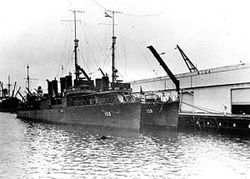-
Government
- Perry Next
-
Resident Info
- AmeriCorps Perry
- Tree Trimming and Ash Tree Removal
- City Projects Blog
- Downtown Improvements
- City Newsletters
- Public Service Announcements
- Snow Ordinances
- Fireworks
- Waste Water Treatment Plant Project
- Pet Registration
- Garbage & Recycling
- Yard Waste
- Property Maintenance
- Rental Property Code Enforcement
- Community Calendar
- Contacts & Staff Directory
- Links of Interest
- Maps
- Media/ News
- Chamber of Commerce
-
Business & Development
- Culture & Recreation
- I Want To . . .
 USS Chew USS Chew Because we are rapidly approaching Veterans’ Day on November 11, 2013, it is appropriate that we honor a local business owner who was serving aboard the USS Chew DD-106 when Pearl Harbor was bombed on December 7, 1941. That business man was Dale Elifrits who owned and operated Elifrits Radiator Shop in Perry. Dale who was born and raised in Spirit Lake, Iowa entered the United States Navy in the fall of 1939. Shortly after his boot camp training he was stationed aboard the USS Chew DD-106. The USS Chew was one of 111 Wickes-class destroyers built by the United States Navy from 1917 thru 1919. There were 113 officers and enlisted personnel on the USS Chew at the time she was anchored at Pearl Harbor. Members of the crew opened fire on the Japanese planes with 50 caliber machine guns. Dale related that he was able to see the faces of the Japanese pilots as they flew over the ships anchored in the harbor. The crew of the USS Chew kept firing during all three waves of attack by the Japanese pilots. During the ensuing battle the crew of the USS Chew is credited with hitting a Japanese plane, disintegrating the plane in mid-air. They were also able to hit a plane demolishing the tail assembly of the plane. During the battle and rescue efforts of the Battle of Pearl Harbor there were one casualty and one missing in action from the crew of the USS Chew. In retrospect, Dale felt that he was lucky to have been assigned to the USS Chew as it was the larger ships like the Arizona that the targets of the Japanese pilots. From 1941 through the end of World War II, the USS Chew operated out of Pearl Harbor on patrol. She took on periodic duties among the Hawaiian Islands and made occasional trips to San Francisco. With only six months of his enlistment left, on one of the trips to the mainland, Dale left the ship and was stationed in San Diego, California. During his duty in San Diego Dale worked at a naval salvage yard where he worked with sheet metal. He was told by a senior officer at the naval salvage yard that he should look into the radiator shop business as it would be an exploding business as the car industry was rapidly growing. Two important life events occurred during his last six months in the military. He met his wife, who was from Woodward, Iowa and learned the trade of radiator repair. Following his tour of duty with the United States Navy during WWII, Dale Elifrits came back to Iowa and personally constructed a building to house, a new business, a Radiator Shop. The shop is across the street north of the former Perry Sale Barn on Warford Street. Following the construction of the shop, Dale was ready to open his shop in 1946.
If you remember, Dale gained his knowledge of radiator repair from his military training. However, the meticulous talented craftsman that Dale had become made his Radiator Repair Shop successful without the need of advertising. Dale was well-known for the detailed craftsmanship of his work to the point that it wasn’t just local Perry people who patronized the Radiator Shop, the shop was always buzzing in the fall & spring with work on farm tractors and grain trucks that farmers brought into the shop. Anyone who saw the work that he did not only for radiator repair, but in constructing campers & restoring automobiles, was more than happy to have such a talented craftsman do work for them. Dale was a person who could make something out of nothing. As a sideline, Dale built several small pull campers and pick-up mounted campers using the skills that he learned in sheet metal work while he was in the military, working in the Naval Salvage Yard. From the camper design and construction Dale continued on to restoring a 1955 Chevy for his son Keith. There were several coats of hand rubbed lacquer, on the car as well as work done on the engine. In 1984, Dale chose to leave the day-to-day running of the shop to his son Keith. He did however, keep meeting with Max Conaway, Louie Hensen, and other friends on the east side of the shop. Like most businesses, the changes in technology changed the manner in which the shop was run. In the late 80s and early 90s the foreign car market went to plastic side tanks on vehicle radiators and the United States auto makers soon followed suit. Because of this change it was no longer necessary to do some of the soldering on radiators and this coupled with the required special machinery to seal the plastic tanks to the wafer changed the business. The shop had previously repaired heater cores, but changes made it more efficient to replace the core with a new one than to repair the old one. Due to the EPA regulations on air quality and water pollution controls it became necessary to invest in a system to take care of the regulations. The required systems were very costly thus making Keith’s decision the close the shop in 1997. I miss the days of stopping in after work to visit with Dale and Keith. A local business is gone but never forgotten. Comments are closed.
|
Historic Preservation CommissionArchivesCategories
All
|
-
Government
- Perry Next
-
Resident Info
- AmeriCorps Perry
- Tree Trimming and Ash Tree Removal
- City Projects Blog
- Downtown Improvements
- City Newsletters
- Public Service Announcements
- Snow Ordinances
- Fireworks
- Waste Water Treatment Plant Project
- Pet Registration
- Garbage & Recycling
- Yard Waste
- Property Maintenance
- Rental Property Code Enforcement
- Community Calendar
- Contacts & Staff Directory
- Links of Interest
- Maps
- Media/ News
- Chamber of Commerce
-
Business & Development
- Culture & Recreation
- I Want To . . .

